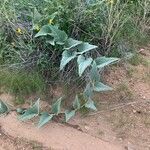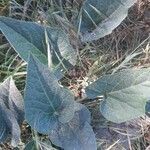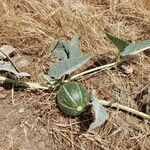Plants perennial; roots tuberous. Stems prostrate, sometimes rooting adventitiously at nodes, ca. 2–10 m, puberulent to scabrous with pustulate-based hairs; tendrils 3–7-branched 3–6 cm above base, hirsute, eglandular. Leaves: petiole 3–12 cm, coarsely hispid to hispidulous with puberulent understory of gland-tipped hairs; blade narrowly triangular or triangular-acuminate to triangular-lanceolate, unlobed or shallowly 2-lobed, (10–)12–30(–40) × (6–)8–20(–30) cm, longer than broad, base hastate-cordate to truncate, margins coarsely and widely mucronulate to denticulate, surfaces densely short-hirsute-pilose abaxially, short strigose-hirsute to hispid-hirsute adaxially, eglandular or minutely sessile-glandular. Peduncles in fruit 5-ribbed, slightly expanded or not at point of fruit attachment, hardened, woody. Flowers: hypanthium broadly campanulate, 10–18 mm; sepals narrowly lanceolate to linear-oblong or filiform-subulate, 10–25 mm; corolla golden yellow, campanulate to cylindric-campanulate, 6–10 cm; anther filaments usually sparsely short-villous with viscid-glandular hairs; ovary hirsute to short-villous. Pepos green with white stripes, white-mottled, evenly yellowish to orange-yellow at full maturity, depressed-globose to globose or oblong-globose, 5–10 cm, smooth. Seeds tan to cream or yellowish, oblong-ovate to ovate-elliptic, 9–13 mm, margins thickened-raised, surface smooth. 2n = 40, 42.
More
A pumpkin family plant. It is a large plant. It has a bad smell. It has a very large root. The root can be 30 cm across and 2.7 m long. It can re-grow from this root. The stems are long and rough. They can be 7-10 m long. The leaves are triangle shape. They are rough and hairy. They can be 25 cm long. The flowers are yellow. They are large and bell shaped. They are 5-10 cm long. The fruit are 10 cm across. They have green stripes when young. They turn yellow when ripe.
Stems rough, trailing from a thick perennial root, often to several m; herbage malodorous; lvs triangular-ovate, 1–2 dm, irregularly and finely toothed and often angularly lobed, rough on both sides; fls yellow, campanulate, 5–10 cm long and wide; fr subglobose, 5–10 cm, greenish-orange, smooth. 2n=40, 42. Dry soil; Mo. to Tex. and Calif., and intr. along railways farther e. Summer. (Pepo f.)
Sandy fields and hills, sandsage prairies, dunes, gypsum hills, rocky soil, calcareous clay loam, grasslands, mesquite scrub, pinyon-juniper, floodplain woods, vacant lots, roadsides, railroad banks; at elevations from 100-2,000 metres.
More
Sandy fields and hills, sandsage prairies, dunes, gypsum hills, rocky soil, calcareous clay loam, grasslands, mesquite scrub, pinyon-juniper, floodplain woods, vacant lots, roadsides, railroad banks; at elevations from 100-2,000 metres.
It is a subtropical plant. It grows in the prairies throughout Texas. It will grow in most soils. It is best in an open sunny position. It is resistant to frost but damaged by drought. It suits arid places.







